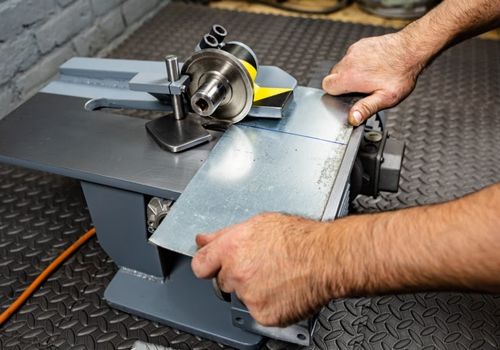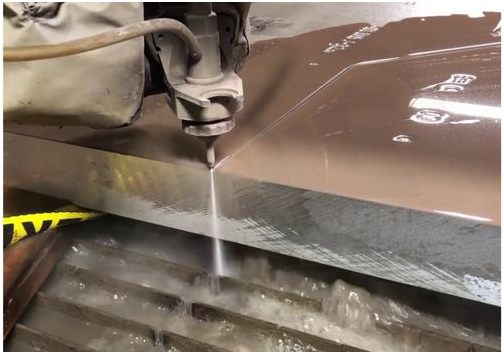
Before cutting aluminum material, read this guide. It discusses some of the effective and simple ways to cut aluminum sheet.
Laser Cutting Aluminum
In laser cutting, you employ a high power laser beam on an aluminum workpiece’s surface to irradiate and melt it. A gas mix of high pressure eliminates the melt by blowing eventually slitting the aluminum material.
Advantages
- High Efficiency: The process is contactless thus causes no surface deformations on the aluminum with reduced burr formation.
- Fast Process: Since it is not mechanical, the cutting process is precise with minimal roughness thus reducing the process time.
- High Precision: Laser cutting aluminum supports cutting of complex patterns by employing numerical control programming.
- No Mechanically Induced Stress: The quick laser cutting process results in a level incision devoid of the inconsistencies of mechanical cutting.
- Reduced Heat Affected Zone: The plate deformation and cutting seam is small resulting in a small cutting heat affected zone.
- Easy to Control: Controlling the laser cutting process is easy by adjusting the program parameters relating to space and time.
Limitations
- Auxiliary Machining: There’s some need for secondary machining to get a tidy finish and planar edge.
- High Processing Cost: The initial cost of acquiring laser cutting equipment and other mitigation efforts towards reflectiveness and thermal conduction increase processing cost.
- Highly Reflective: The reflectiveness of aluminum in carbon (IV) oxide lasers can cause the beam to renter the laser head posing module damage.
- Thermal Conductivity: Aluminum’s tendency to dissipate heat and its heat conduction property make achievement of surface melting and vaporization difficult.
Types of Laser Cutting Equipment for Cutting Aluminum
Some of the most common laser machine you can use to cut aluminum are:

i. CO2Laser Cutting Machine
Employs carbon (IV) oxide in the cutting process and hampered by aluminum’s reflective tendency of energy. In mitigation, you prevent laser module damage by coating the aluminum material.
Additionally, the CO2 laser’s rate of photoelectric conversion is approximately 10%, and using and maintaining the machine is costly. Furthermore, you can only cut aluminium materials not exceeding three millimeters in thickness.
ii. Fiber laser cutting machine
In comparison to carbon (IV) oxide laser cutting machines, the fiber laser cutting machine employs less gas and saves more space. While on the higher price scale, it is much more reliable.
However, damage to a single fiber warrants an entire system replacement. Furthermore, maintaining the fiber laser cutting machine is costly.
Aluminum Cutting With Metal Shears
The metal shears are scissor-like tools you employ in making straight cuts. Use of metal shears is synonymous with aluminum cutting procedures across the world. They find use in small scale aluminum working projects.

Notable features are as follows:
- Useful only on thin aluminum sheets.
- Highly portable since they require no electricity.
- Do not cause thermal stress on aluminum.
- Can achieve challenging cuts.
Plasma Cutting Aluminum

Plasma cutting employs a stream of ionized gas over 20,000°C to induce melting of aluminum material. By expelling the melt material from the plane of action, you result in a cut.
Plasma cutting entails formation of an electric arc with the workpiece as an anode and an electrode. Formation of the narrow plasma jet at high velocity and temperature is through arc constriction by the electrode.
Interaction of the plasma jet and workpiece results in recombination and production of great heat which melts the aluminum. Common plasma cutting gases are:
- Argon,
- Argon/Hydrogen, or
- Nitrogen
Advantages
- You can employ air as cutting gas but with specific zirconium or hafnium electrodes.
- Cutting aluminum is easy when employing a plasma cutter.
- When using low amperage plasma cutters, you can cut thin aluminum materials between five and ten millimeters.
Drawbacks
- Cutting thick aluminum materials with plasma cutter is difficult.
- Cutting aluminum-lithium alloys when employing a water tables can result in an explosion.
- Plasma cutting results in heat production which can cause build-up of slag.
Aluminum Cutting with Saw
There are many saw types you can employ in cutting aluminum as follows:
i. Circular Saw: Are simple to operate functioning best when making straight cuts on thin aluminum metal sheets.
ii. Hacksaw: Works best for cutting short lengths of aluminum sheet or bar.
iii. Jigsaw: These allow you to make curved cuts alongside other non-straight cuts impossible with circular and table saws.
iv. Band Saw: Is ideal for thick aluminum sheets employing standard steel for a blade or one laced with carbide. Requires use of a block board underneath the aluminum sheet and lubricants to aid in cooling during the cutting process.
v. Table Saw: Table saws offer a technique to make a straight edge cut on aluminum sheet metal.
Advantages
- Saws are cheaply and widely available making them cost effective for small aluminum cutting operations.
- You can cut both thin and thick aluminum materials with saws.
- Saws are portable and do not require electrical power.
- Some saws are capable of making complex pattern cuts.
Limitations
- Using saws requires further processing for achieving smooth edges.
- When manually employed, using saws to cut aluminum is cumbersome thus not suitable for large scale use.
Water Jet Cutting Aluminum
Cutting aluminum using waterjet technology achieves results of the highest-quality. In aluminum waterjet cutting, you concentrate a high-pressure stream of water on aluminum material to induce cutting. Adding an abrasive material in the water stream makes the process easier and quicker.
Advantages
i. Accurate Cuts: Due to the water jet’s small size, you can achieve cutting results of high-precision to the tune of ±0.005.
ii. Environment-Friendly: Waterjet technology does not employ any harmful substances and employs a closed loop system for water recycling.
iii. Excellent Cutting: High-quality cutting of aluminum material without additional surface improvements is possible with waterjet cutting. The lack of heat-affected zones prevents material distortion resulting in a smooth finish.
iv. No Thermal Damage: Waterjet cutting employs a cold cutting technique by only utilizing the water’s sheer force in material removal. This preserves the material’s integrity given there is no temperature rise.
v. Unlimited Cut Designs: Waterjet cutting can produce cutting patterns in 3-D as well as 2-D allowing the creation of complex shapes.
vi. Various Thickness Achievable: Aluminum materials including sheets and solid blocks of various thicknesses are subject to waterjet cutting.

Application
Waterjet aluminum cutting finds use in the following instances:
- Aluminum Foil: Waterjet cutting is a safe, no-contact hygienic technique allowing use in cutting food grade materials such as aluminum foil.
- Artistic Use: A waterjet’s capability of cutting intricate patterns allows use in art projects such as metal sculpture and making decorative pieces.
- Building: You can employ a waterjet cutter to cut aluminum sheets into siding and scaffolding for building projects.
- Insulation Purposes: Waterjet cutting is the best tool for making thinly cut aluminum sheets for ducts and insulation.
- Kitchenware: Food grade kitchenware such as pans and pots are a result of waterjet aluminum cutting in various thicknesses.
- Making Furniture: A waterjet cutter allows shaping of aluminum sheets and to produce furniture such ad chairs and tables.
- Roofing Systems: Roofing systems in different constructions find use of aluminum sheets cut by waterjet process.
Other Aluminum Cutting Processes
There are other notable aluminum cutting processes that employ different tools and equipment as follows:
Drilling Aluminum
Creating holes in aluminum sheets and blocks is possible through drilling by employing a portable drill, a drill press, or a CNC machine. Lubrication is important during the drilling process to prevent tool wear and damage and also enhance hole parameters.
Milling Aluminum
It is the intricate sculpting of aluminum metal into desired shape by material removal using a milling machine. A milling machine encompasses a rotating cutter and a movable worktable with capacity for manual or computer numerical control operation.
Turning Aluminum
In turning, you remove material by employing a linear moving cutting tool, usually a lathe, on a rotating workpiece. Material removal is possible along the length and breadth of the workpiece.
Grinding Aluminum
Grinding entails an abrasive technique in material removal typically at the latter stages employing equipment called grinders. These grinders possess an abrasive wheel fashioned from hard material such as diamond.
Aluminum Cutting Tips & Tricks
The following tips are useful when cutting aluminum material:
- Clamping
For optimum results, clamp your aluminum workpiece which offers stability and thus enhances cut accuracy. Clamping also increases safety by reducing the possibility of the workpiece to hurt the user from sudden movement.
- Use Correct Set-Up
A proper setup necessitates considerations of blade size, path of travel and thickness for sustaining a clean cut. For instance, you have to provide clearance underneath the workpiece when employing a circular saw.
- Employ Lubrication.
Metal-cutting lubricants aid in chip and swarf removal as well lessening chatter and irregularities stemming from the cutting process. Such lubricants include metal wax and WD-40.
- Wear Safety Gear
Wear the appropriate safety gear whenever cutting aluminum due to the toxic dust and potentially explosive created when grinding aluminum. Such gear includes overalls, ear plugs, safety glasses and hand gloves. A full face shield offers better protection.
- Utilize Blades with Smaller Diameter
Cleaner, more precise cuts are possible by employing smaller blades, however, they shouldn’t be too thin to be easily broken. Additionally, having an insufficient blade size could prevent you from cutting thicker aluminum sheets.
- Use Necessary Hand Tools
There are several options for hand tools such as chisels, angle grinders, carbide blades, and shears. Employ the appropriate tools to facilitate your cutting process into the desired quality.
Conclusion
As you can see, aluminum cutting process is simple and straightforward. All you need is a suitable sheet metal cutting technology.
More Resources:
Laser Cutting – Source: Wikipedia
3 Ways to Cut Aluminum – Source: Wiki How
Plasma Cutting – Source: Fractory
Water Jet Cutter – Source: Wikipedia
How to Cut Aluminum – Source:Kevin Caron




